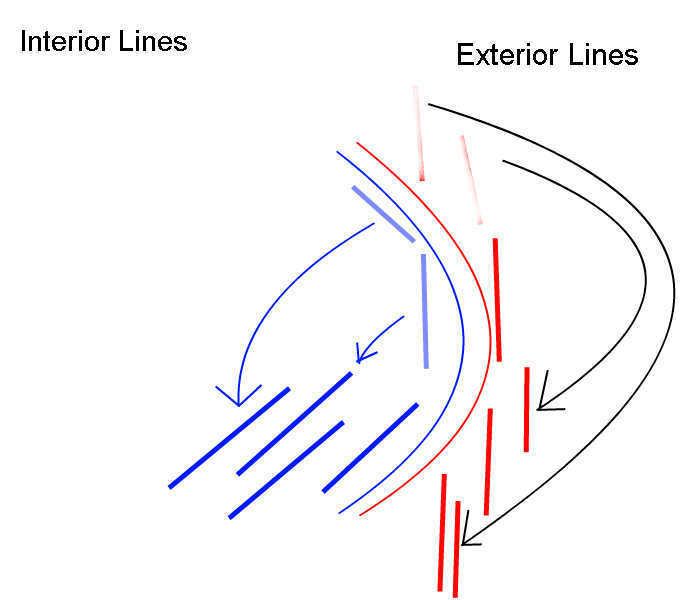 | ||
Interior lines is a strategy of warfare that is based on the concept that lines of movement, communication, and supply within an area are shorter than those on the outside or exist on the inside exclusively. As the area held by a defensive force shrinks, the advantages increase.
Contents
Using the strategy of interior lines, a surrounded force can more easily supply, communicate, and move its forces around, and it can mount a series of quick attacks on the forces encircling it.
Tactic
In the context of battle field tactics, it allows for the greater concentration of resources at a greater rate then an adversary can. That allows for higher concentrations of resources, firepower and manpower than an adversary can and so affords greater tactical flexibility. The resources are presumably employed against an adversary in a way to which they are not prepared to respond. The tactic simultaneously ensures a slower concentration of similar resources at a given point by an adversary:
- At the Battle of Dyrrhachium, the Optimates, led by Gnaeus Pompeius Magnus, defeated the Populares led by Gaius Julius Caesar when Caesar attempted to encircle the numerically superior Optimates at Dyrrhachium in 48 BC.
- During the Battles of Lexington and Concord, Brigadier General Hugh Percy utilized interior lines during the British retreat, as his men were often surrounded by militia.
- At the Battle of Jena-Auerstedt, Louis Nicolas Davout employed interior lines to defeat the main Prussian army.
- At the Battle of Wagram, the French under Napoleon I defeated the Austrians by acquiring interior lines and achieving local numerical superiority.
- George Gordon Meade used it against Robert E. Lee at the decisive Battle of Gettysburg in 1863.
- Battle of Rorke's Drift. A vastly-outnumbered British force managed to defeat a Zulu army by using the advantages of the small area to defend.
Strategy
As a strategy, it is commonly employed to cut armies off from reinforcements supplies, or prevent allies from uniting their forces. That usually allows for an adversary that may not be numerically superior to gain a numerical superiority over an adversary in a given locality, which increases the chances of overpowering an enemy and defeating it. By extension, in overpowering an enemy, an adversary hopes to demoralize it to a sufficient degree to bring it to political terms.
Examples
- At the Battle of Montenotte, the First French Republic under Napoleon defeated the Austrians and destroyed an entire corps, thereby destroying the link between the Austrians and their allies Kingdom of Sardinia. As a result of the victory, the Sardinians were separated from Austria and were unable to defeat the French or rejoin the Austrians. They eventually sued for peace.
- Frederick the Great's operational strategy, in his prosecution of the Seven Years' War against the separate armies of the French, the Russians and the Austrians, can be considered an example of the advantage of interior lines in warfare.
- It also gave the Reds a distinct advantage over the Whites in the Russian Civil War.
- General Robert E. Lee used the strategy during the Battle of Antietam during the American Civil War in 1862.
